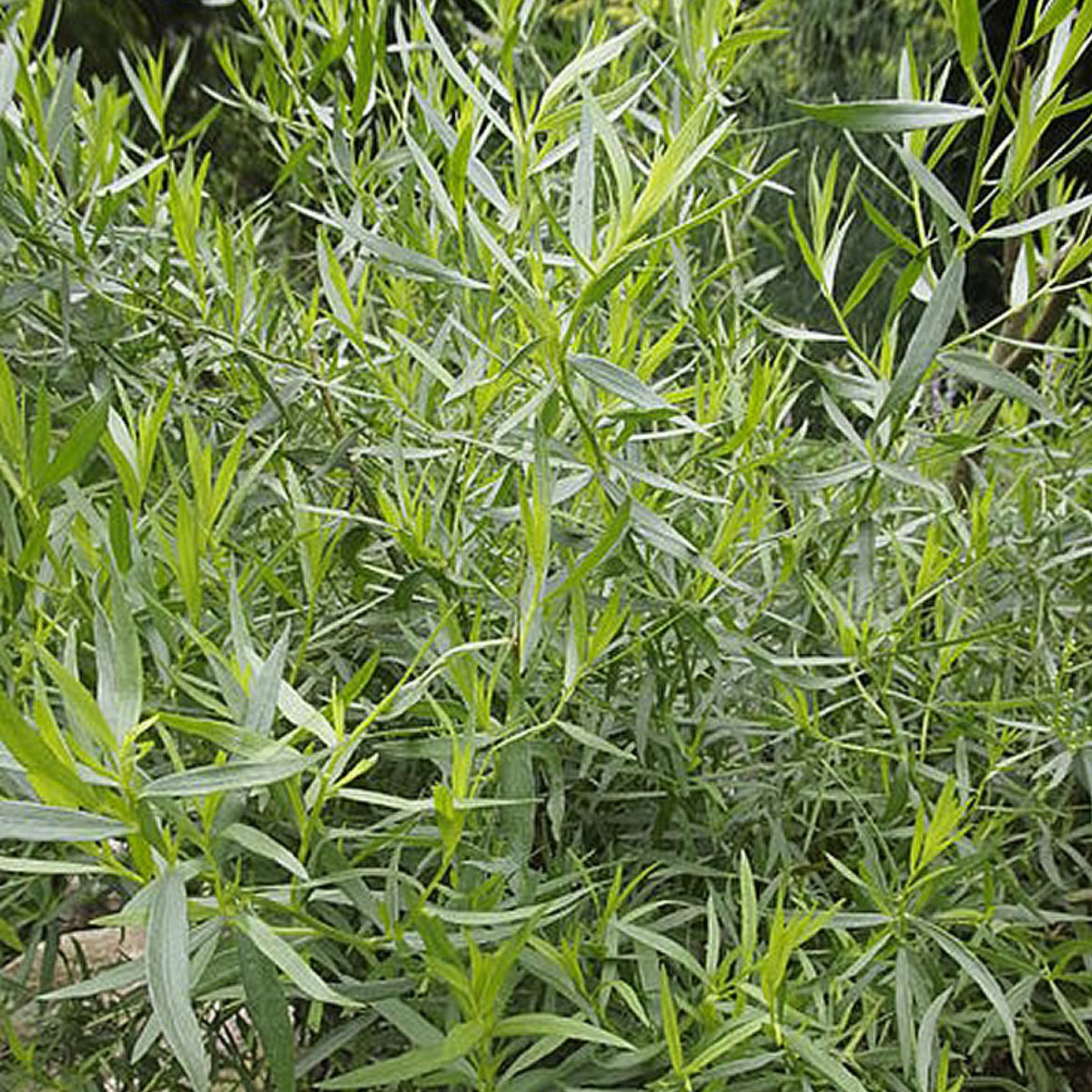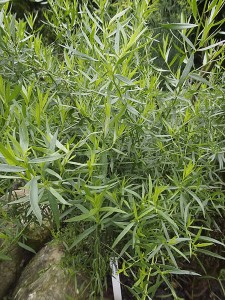Common name: French Tarragon, True Tarragon
Family: Asteraceae
Distribution and habitat: Artemisia dracunculus var. sativa is found natively in a number of areas of the Northern Hemisphere. It is native to soils that have relatively little water retention. It is now cultivated widely in Europe, Asia, and the US.
Description: Artemisia dracunculus var. sativa is perennial herb and the only sub-species from Artemisia dracunculus species cultivated for use of the leaves as an aromatic culinary herb. It is noted for the pungent anise-like flavor and aroma of its leaves.
It is a shrubby perennial which typically grows 45-60cm (18-24 inch) tall, with slender branched stems. The leaves are lanceolate, 28cm (0.8-3 inch) long and 210mm broad, glossy green, with an entire margin. The flowers are produced in small capitulae 24mm diameter, each capitulum containing up to 40 yellow or greenish-yellow florets. Artemisia dracunculus var. sativa, however, seldom produces any flowers. The flowers will be sterile. This plants are reproducing only asexual. Artemisia dracunculus var. sativa has rhizomatous roots and it readily reproduces from the rhizomes.
Gardening: Artemisia dracunculus var. sativa is the variety generally considered best for the culinary proposes. It is normally purchased as a plant and some care must be taken to ensure that true Artemisia dracunculus var. sativa is purchased. It is a perennial and it normally goes dormant in winter. New growth will start in spring. Cut the remaining dried parts of the plants to the ground in early spring. Periodic light pruning will encourage new growth.
It likes a hot, sunny spot, without excessive watering. This plant is frost and drought tolerant.
It also may be effectively grown in containers or window boxes.
Location: Artemisia dracunculus var. sativa plant prefers full sun positions, but appreciates a sheltered location (afternoon shade) in hot areas. Grow this plant in a well ventilated location.
Soil: Well-drained soil is the number one requisite of a good growing site for Artemisia dracunculus var. sativa plants. Raised beds or ridge culture are particularly desirable in areas of heavy soils and poor natural internal soil drainage. Compost, peat or other organic soil amendments will improve soil aeration and drainage. Please note that adding a small amount of sand may actually make conditions worse in fine-textured, tight soils.
This plant prefers a neutral soil (pH of 6.9). Avoid wet soils.
Irrigation: Artemisia dracunculus var. sativa has average water needs; Water it regularly, but do not overwater it. Irrigation may be necessary to maintain high quality late into the season. Allow soil to dry between thorough waterings.
Fertilising: A fertilizer program similar to a good vegetable garden maintenance level is usually adequate, except in particularly poor soils. Apply fertiliser once every month during the growing season.
A summer mulch to cool the soil and keep the leaves clean may be effective, though winter mulch may keep the crowns too wet and actually encourage winter kill.
Propagation: Artemisia dracunculus var. sativa is never grown from seed as the flowers are sterile, instead it is propagated by root division. Dividing the clumps every 3-4 years will help keep plants robust, but replacement of the plants should be considered if plant vitality declines. Root division can be as simple as digging up the clump and chopping it into quarters with a spade, then replanting these divisions for a 4:1 yield of new plants.
Artemisia dracunculus var. sativa can be also propagated by cuttings. Propagation should then be planned to avoid the natural dormant season and conditions, which tend to stunt or stop lush growth. Examine the plant early in the morning. This is the best time to gather the cuttings. Using a sharp knife, scissors or razor blade, cut healthy stems right below the leaf node. The leaf node is where the leaf emerges from the stem. Each stem should be 10 to 12cm (4 to 6 inch) long. Remove all the lower leaves on the bottom third of the stem, but the top section must have three or four leaves. Place the cut end of the stems in a damp paper towel. This prevent the cuttings from drying out before planting them. Use a 10cm (4 inch) pot for each cutting. Cover the drainage holes at the bottom with small rocks or clay-pot fragments. Fill the pots with well-drained potting soil. Water the soil, moistening it thoroughly. Remove a stem from the paper towel. Dip the cut end in water. Tap the stem to remove the excess water and then dip the wet end in rooting hormone. Tap the stem again to remove the excess rooting hormone.
With the blunt end of a pencil or a dibble, form a hole in the soil. Insert the stem end with rooting hormone into the hole. Gently firm the soil around the stem with the fingers to help hold it upright. Repeat this process for each cutting.
Place the pot in a clear plastic bag, but leave the bag open to allow for air circulation. Find a bright window to place the propagating pots. Do not expose them in direct sunlight.
Every day, check the soil for moisture. The soil needs to be kept moist, but not soggy or the cuttings will rot. Begin watching for new growth after a month. This will be an indication that the cuttings have rooted. Remove the plastic bag. Now they can be transplanted in the garden. Plant them outdoors, only when the temperatures are warm. Space the plants 0.4 to 0.6m (1.5-2 feet) apart.
Dormancy: Artemisia dracunculus var. sativa is a deciduous perennial. It produces beautiful flavoured leaves in Spring to Autumn.
Availability: Artemisia dracunculus var. sativa is are sold as container plant and is sold always as 'sativa' cultivar or varieties. To ensure that the plant is truly Artemisia dracunculus var. sativa, do a taste test. The leaves will have an anise flavor and it can make the mouth feel numb.
On the other hand, Artemisia dracunculus sold under the species name without reference to cultivar or variety may be the less pungent Russian tarragon (Artemisia dracunculoides), which is considered by most cooks to be significantly inferior for culinary use. The leaves will still taste anise flavor, but it will be very mild and it would not have as big a numbing effect.
Seeds are invariably those of Russian tarragon as Artemisia dracunculus var. sativa is sterile.
Spanish, winter, Texas and Mexican tarragon are all the same plant - Tagetes lucida. This plant is a good tasting substitute for Artemisia dracunculus var. sativa.
One plant will be enough for home uses.
Problems: Susceptible to root rot in moist soils, particularly poorly drained ones.
It does not like acid, wet soil, which can cause root rot and mildew.
Because it is a cool-growing plant when it is grown in warm climates zones will often lead to disappointing results. There are lots of production issues and dormancy related problems meaning that Artemisia dracunculus var. sativa needs some special conditions to survive: bright light, cooler conditions, and avoid over fertilization for best results.
Harvesting: There should be a moderate harvest the first summer and a full harvest in the second, third and possibly fourth summers. A few fresh leaves are harvested by snipping with a scissors. Begin harvest of about 1/3 of shoot growth starting as soon as plants have fully expanded leaves in mid spring. Cut material should be cleaned, if necessary and then packaged immediately to slow wilting, which begins as soon as tips are severed from the plant. The remainder of the plant will be reinvigorated by the harvest and will branch and regrow to provide multiple harvests throughout the season. Plants should be cut back frequently during the growing season to keep fresh new growth coming. As dormancy begins in early fall, harvest should stop, mainly because quality rapidly deteriorates. It is best not to shear off the unsightly brown tops in the fall, as this may lower plant hardiness through the winter.
Companion plants: Artemisia dracunculus var. sativa grows well together with other culinary herbs such as Salvia officinalis (Sage), Rosmarinus officinalis (Rosemary), Thymus vulgaris (Thyme).
Uses: Fresh leaves may be harvested at any time for cooking. Leaves may also be dried for later use by cutting the leafy stems in mid-summer and hanging them in bunches in a cool, dry location. Dried leaves should then be stored in airtight containers. However, this herb is of much higher quality in the fresh state than when dried. It is best used fresh, however, it can be frozen or preserved in vinegar.
Very desirable herb garden addition also looks great in any bed, border or container. Use fresh or dry leaves to season soups, sauces, and vinegars.
Height: 1.50 to 3.00 feet
Spread: 1.50 to 2.00 feet
Hardiness zone: 5a-8b
Begonia propagation f...
Essential Nutrients f...
Portulacaria afra
Tillandsia recurvata
Tillandsia stricta
Columnea microphylla
Clivia miniata
Cleyera japonica
Clerodendrum thomsoni...
Cleistocactus strausi...



